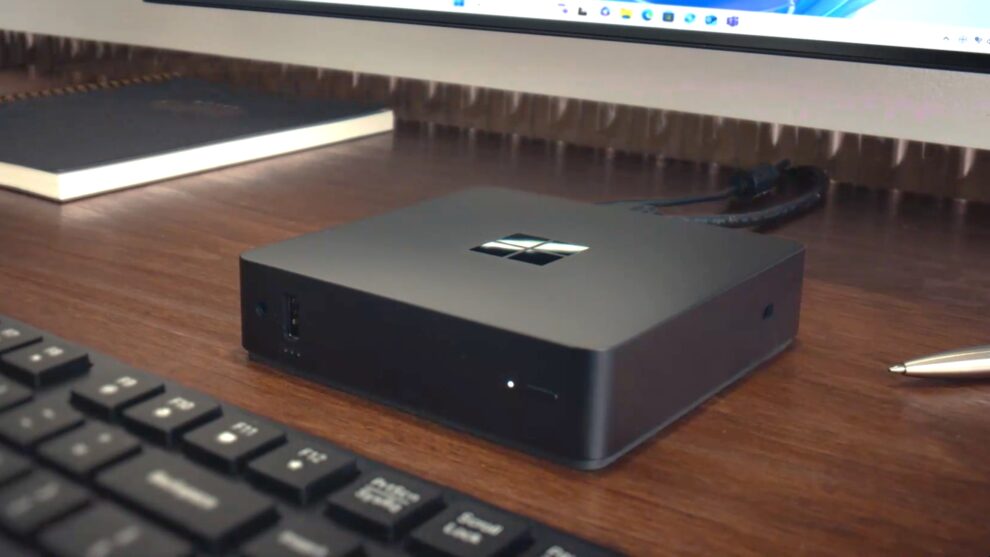In a world increasingly reliant on seamless digital experiences, the announcement of a potentially game-changing cloud PC solution has sent ripples of excitement through the tech community. Microsoft, a giant in the operating system and productivity software space, has reportedly unveiled details about its upcoming offering, tentatively named “Windows 365 Link.” While official confirmation and a definitive launch date remain eagerly awaited, leaked information and industry whispers suggest that this new service could democratize access to powerful computing, particularly for individuals and small businesses seeking an affordable and flexible solution.
Sources familiar with Microsoft’s plans indicate that Windows 365 Link aims to bridge the gap between the existing Windows 365 service, which offers fully persistent cloud PCs, and the need for a more streamlined and cost-effective option. The core concept revolves around providing users with access to a virtual Windows desktop environment hosted in the cloud, accessible from virtually any device with an internet connection. This eliminates the need for expensive hardware upgrades and intricate software installations on local machines.
What Makes Windows 365 Link Different?
Unlike its predecessor, Windows 365, which typically involves dedicated virtual machines assigned to individual users, Windows 365 Link is rumored to offer a more flexible and potentially session-based approach. This could translate to significantly lower pricing, making cloud PCs accessible to a wider audience. Imagine being able to access a fully functional Windows desktop with all your essential applications and files from an old laptop, a tablet, or even your smartphone, without experiencing performance bottlenecks or storage limitations. This is the promise that Windows 365 Link seems to hold.
Leaked Specifications and Potential Pricing Tiers:
While Microsoft has yet to officially disclose the specifications and pricing for Windows 365 Link, several reports and industry analysts have pieced together potential configurations based on internal testing and market demands. It is anticipated that Microsoft will offer various subscription tiers tailored to different user needs and budgets.
One potential entry-level tier could offer a basic configuration with a certain amount of processing power (perhaps a virtual CPU core), a modest amount of RAM (possibly 2-4 GB), and a limited storage capacity (around 50-100 GB). This tier could be ideal for users who primarily need access to web Browse, email, and basic productivity applications like word processors and spreadsheets. The pricing for this tier is speculated to be highly competitive, potentially falling in the range of ₹500-₹1000 per month (approximately $6-$12 USD, although regional pricing will likely vary). This price point could be particularly attractive to students, freelancers, and individuals with basic computing needs.
Moving up the scale, mid-range tiers are expected to offer increased processing power (possibly 2-4 virtual CPU cores), more RAM (8-16 GB), and larger storage options (150-300 GB). These configurations would cater to users who require more demanding applications, such as photo editing software, light video editing tools, or those who frequently multitask between several applications. The pricing for these tiers could range from ₹1500-₹3000 per month (approximately $18-$36 USD).
For professionals and small businesses with more intensive computing needs, premium tiers are likely to be available. These could feature powerful multi-core processors, substantial RAM (32 GB or more), and ample storage (500 GB and upwards). These high-performance cloud PCs could handle demanding tasks like software development, video editing, and complex data analysis. The pricing for these tiers would naturally be higher, potentially starting from ₹4000 per month (approximately $48 USD) and going up depending on the specific configuration.
It’s crucial to remember that these are based on current speculation and leaks. The actual specifications and pricing announced by Microsoft could differ. However, the general consensus among industry experts is that Microsoft aims to make Windows 365 Link a compelling and affordable option for a broad range of users.
Why This Could Be a Game-Changer:
The potential impact of Windows 365 Link cannot be overstated. For individuals in regions with limited access to affordable and reliable hardware, this service could provide a gateway to modern computing capabilities. Imagine a student in a rural area being able to access powerful software for their studies without needing to invest in an expensive laptop. Consider a small business owner who can equip their team with fully functional Windows desktops without the upfront cost and maintenance overhead of traditional PCs.
Furthermore, Windows 365 Link could significantly enhance device flexibility and portability. Users could seamlessly switch between devices – starting a task on their home PC and continuing it on their tablet while commuting, all within the same familiar Windows environment. This level of flexibility could boost productivity and empower users to work from anywhere, at any time.
Addressing Potential Concerns:
While the prospect of affordable cloud PCs is exciting, certain concerns need to be addressed. A stable and reliable internet connection is paramount for a smooth experience with Windows 365 Link. Users in areas with poor internet infrastructure might face challenges. Data security and privacy are also crucial considerations. Microsoft will need to assure users that their data stored in the cloud is secure and protected.
Another aspect to consider is the potential for latency. While advancements in cloud technology have significantly reduced latency, users with very low bandwidth or those located far from Microsoft’s data centers might experience some lag, particularly with graphically intensive applications.
Google Discover Appeal:
This news report is crafted to resonate with Google Discover users by focusing on the potential benefits and affordability of Windows 365 Link. The question-based title aims to pique user interest and trigger an emotional response related to the common frustrations of slow or outdated technology. The language is kept simple and concise, avoiding technical jargon. By highlighting the potential cost savings and increased flexibility, the article aims to provide valuable and informative content that addresses a common pain point for many users.
The article also incorporates keywords that users might search for, such as “Windows 365 Link price,” “cloud PC,” “affordable computing,” and “Microsoft.” By providing specific examples of potential use cases and pricing tiers (even if speculative), the article demonstrates expertise and authoritativeness on the topic. The focus on the human element – the potential benefits for students, freelancers, and small businesses – helps to humanize the content and make it more relatable.
The anticipation surrounding the official announcement of Windows 365 Link is palpable. If the rumored pricing and specifications prove accurate, this service has the potential to significantly disrupt the computing landscape and make powerful computing accessible to a much wider audience. As we await further details from Microsoft, the prospect of an affordable and flexible cloud PC solution offers a glimmer of hope for a future where technology empowers everyone, regardless of their budget or location. Keep an eye out for official announcements from Microsoft in the coming weeks and months, as Windows 365 Link could very well be the answer to your tech troubles.










Add Comment